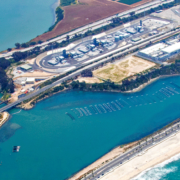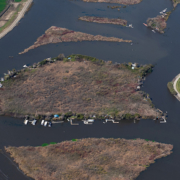The San Diego County Water Authority today praised Gov. Gavin Newsom for taking a proactive, far-sighted approach to water supply planning for California, and pledged to help the governor advance his portfolio strategy for water security in the face of a changing climate.
In a letter to Newsom, Water Authority Board Chair Jim Madaffer thanked the governor for the “wisdom and leadership” shown last week with the issuance of Executive Order N-10-19 and invited the governor to tour San Diego County’s cutting-edge water facilities.
Newsom’s order directed his administration to “identify and assess a suite of complementary actions to ensure safe and resilient water supplies, flood protection and healthy waterways for the state’s communities, economy and environment.” Newsom then directed state agencies to scrap Brown Administration plans for a $18 billion two-tunnel system for moving water through the Sacramento-San Joaquin Bay-Delta in favor of a one-tunnel system.
“We congratulate you on Executive Order N-10-19 and stand ready to support you and work with other stakeholders to ensure its success,” Madaffer wrote to Newsom. “If state and federal dollars are prioritized to support local, integrated planning solutions, we will realize the State’s 2009 promise to reduce demand on the Bay-Delta.”
Portfolio Planning For Water Security
The Water Authority has a long history of both portfolio planning for the region’s water security and supporting a portfolio approach to address mounting environmental and water supply challenges in the Bay-Delta, the hub of the State Water Project.
“Almost two decades ago, the Water Authority’s Board of Directors chose to take affirmative steps to change what had been an ‘end-of-the-pipeline’ mentality, when our agency relied greatly on water imported from the Bay-Delta,” Madaffer said. “In other words, we embraced then the intent of Executive Order N-10-19, and believe our experience is proof that it can be done.”
In 2013, the Water Authority joined several Southern and Northern California water districts, Natural Resources Defense Council, and other conservation groups in proposing a Portfolio Alternative for the Bay-Delta. That proposal included a single tunnel, increasing water storage south of the Bay-Delta, and significant investments in local and regional water supplies.
That approach didn’t gain enough support in the Brown administration, but it aligns closely with Gov. Newsom’s executive order.
Strategic partnerships
The portfolio approach also aligns with what history has shown to be a highly successful strategy in San Diego County, which relied almost entirely on water supplies controlled by external interests in 1991.
“After suffering the devastating impacts of drought and water shortages that year, our community got to work, determined to gain local control over the cost and reliability of our water,” Madaffer said. “Since then, the Water Authority and its member agencies have invested over $2 billion in local projects.”
Those investments include:
- The nation’s largest agricultural water conservation and transfer agreement with the Imperial Irrigation District
- The first new dam in the county in more than 50 years at Olivenhain Reservoir
- The nation’s largest seawater desalination plant, producing up to 56,000 acre-feet of water annually
- The raising of San Vicente Dam, more than doubling its capacity
- Water-use efficiency programs that have helped reduce per capita potable water use by more than 40 percent in San Diego County
“Every dollar of investment the Water Authority has made represents a commensurate reduction of take on the Bay-Delta,” said Madaffer’s letter.
He noted that the Water Authority and its member agencies are still at work, with more local projects on the drawing board, including a Pure Water potable reuse program being developed by the City of San Diego and the East County Advanced Water Purification Project.
“We are also continuing to plan for the future, with an upcoming study that will explore water, conveyance, storage, treatment and energy opportunities with strategic partners in Imperial Valley, Mexico and across the Southwest,” Madaffer said. “This initiative is the next generation of the Water Authority’s evolution, and the ‘poster child’ for your Portfolio Alternative.”
The Water Authority is looking at new integrated solutions such as a storage account in Lake Mead that would help raise water levels in the drought-stressed reservoir and avoid formal shortage conditions that could hamper water deliveries across the Southwest. The Water Authority also is supporting a Salton Sea action plan that will protect both the environment and public health; binational opportunities with Mexico; and clean energy generation.




